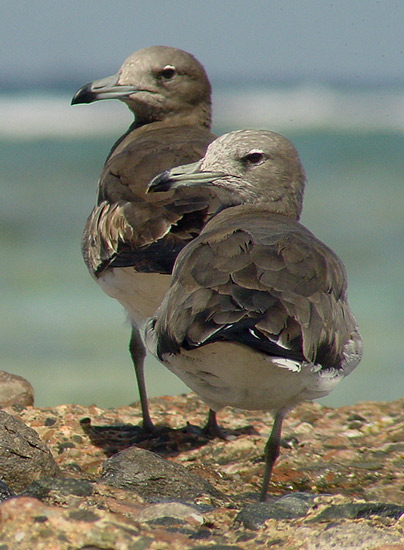 White-eyed Gull (L. leucophthalmus)
& Sooty Gull (L. hemprichii)
White-eyed Gull (L. leucophthalmus)
& Sooty Gull (L. hemprichii)
(last update:
Sooty Gull L. hemprichii 3CY, March 04 2002, visitor's centre of Nabq National Park, SE Sinai, Egypt.
With 1st winter Sooty Gull in the background.
Note the slight differences between first and second winter birds. In second
winter the tail-feathers are second generation feathers and show various amount
of black, creating a broken tail-band. In first winter, the juvenile tail is
completely bleached brown with abraded fringes. In second winter, the juvenile
pointed primaries with abraded tips have been replaced for black primaries with
a rounded top. Note that second generation inner primaries already show white
tips in Sooty Gull, like in many medium-sized gulls, e.g. Common Gull (L.
canus). They are visible just beneath the tertials.
The wing-coverts are all second generation at least and look neat compared to
the very abraded juvenile wing-coverts of the first winter bird. The complete moult to second
winter takes place between probably August and May; subsequently, feathers show various stages of
wear. The last replaced tertials and wing-coverts appear dark brown-grey as in adults.
Earlier required feathers show already some wear in the
fringes. Moult may still be in progress in February as is indicated by the few
moult gaps in the wing-covert rows.
Note the stronger, straight bill compared to White-eyed Gulls. It has a
yellowish grey base and a black tip. The ill-defined buffish crescent is much
less obvious than similar aged White-eyed Gulls. Note the lack of any blackish
feathers on the head and neck, which are typical for White-eyed Gull. The legs
are still greyish.
